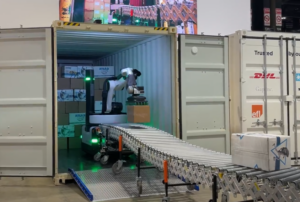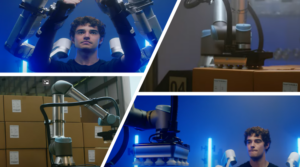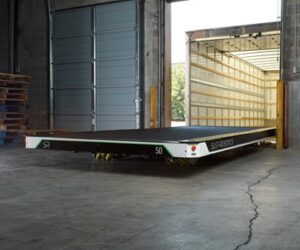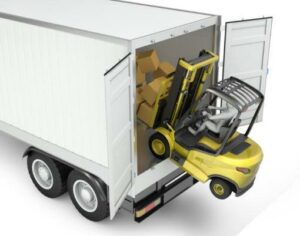A Look at Automated Trailer Unloading Systems
You are missing out if you’ve never experienced the joy of unloading a floor-loaded container! For years, the task of unloading trucks and trailers has been a physically strenuous and time-consuming job. Not only can it be a source of workplace injuries, but it can also slow down the productivity of warehouses and transportation companies. As far as warehouse tasks go, manually unloading floor-loaded containers is worthy of automation.
Thankfully, with the advancement of technology, there has been a shift from manual labor toward automation.
Why Are Trailers Floor Loaded?
I can’t buy my kids an Oscar Meyer Lunchable without having a flashback of my early days in Warehousing. When I would open the trailer door and see the boxes stacked floor to ceiling (no pallets), I wondered how this would all get unloaded, sorted, and put away. At least I had Skinner to help me out. I’m pretty sure he was the inspiration for Mr. Frederickson from the movie Up, only a little grouchier. He would yell at me whenever I carried more than one box, “You’re stealing my overtime!”
Trailers aren’t loaded this way to build up one’s work ethic. That is just a fringe benefit. Loading trailers this way has several advantages that can lower operating costs.
- Reduces Freight Costs: When done properly, floor loading helps to maximize the available space in a truck or trailer, meaning more goods can be shipped in one go. This reduces the required trips, and less air is shipped, reducing freight costs.
- Maximizing Space: Floor loading allows for bulkier items to be transported that otherwise would not fit in other packaging types. This maximizes the space in the trailer and ensures that the available capacity is utilized to the fullest extent.
- Improved Safety During Transport: Goods that are floor loaded are typically more secure and less likely to shift or fall during transport. This minimizes the risk of damage to the goods and ensures the shipping process’s overall safety.
Automated Trailer Unloading Systems
Automated trailer loading and unloading systems provide supply chain and material handling teams with a safe solution. The technology reduces manual labor, improves accuracy, and increases throughput – all needed to keep up with the rising demands of retail consumers.
- Stretch from Boston Dynamics With a stable base and a lightning-fast processing system, Stretch can move boxes quickly and accurately, even in the most challenging conditions. Its small footprint allows it to navigate between containers without costly infrastructure seamlessly. “We (Boston Dynamics) are working on tough and strenuous applications for operators in less than desirable environments. Container unloading, for example, can be really hot and ergonomically not the best job.” Nicholas De Keijser, Director of Sales at Boston Dynamics, Episode 336

- The TruckBot by Mujin is a game-changer, providing a viable solution to a longstanding problem in the industry. By leveraging advanced gripper technology, the TruckBot can unload at a rate of up to one thousand cases per hour. Unlike other solutions that rely on robotic arms, the TruckBot feeds the cases directly onto a conveyor, streamlining the process and saving precious time. “We can deploy the TruckBot very quickly. It takes around a day to get the electromechanical work done, and we can be up and running within a week.” Josh Cloer, Director of Sales at Mujin Corp.
- Contoro Robotics trailer unloading robots provide automation flexibility with a “Robots as a Service” model and per-container rates without purchasing equipment. They can palletize freight directly and build complicated stacking patterns, allowing customers to gain greater accuracy by providing SKU or LOT data. With this technology, discrepancies between what is on the packing list and what is physically present can be quickly identified and resolved. “We always keep a human in the loop, meaning that when our AI needs intervention, we have a human wearing our exoskeleton. That human can remote in and operate the robot all while the AI continues to develop.” John Cook, Business Development with Contoro Robotics

- Pickle Robots offer a highly efficient truck unloading solution that can be used with any power or gravity flex conveyor without requiring any modifications to the trailers. This versatile system can achieve 600+ packages per hour.
- Slip Robotics provides an automated truck loading system and unloading system for warehouses using traditional forklifts to load and unload palletized cargo from trailers. Instead of entering trailers with a forklift, operators stage freight onto the uniquely designed Slipbot AMRs and carry multiple pallets autonomously into and out of trailers. “Slip cuts loading/unloading and idle times by over 90%, down to <4 minutes, compared to typical 40-90+ minutes with forklifts,” says Jordan Sanders, VP of Business Development at Slip Robotics. “Our uniquely designed Slipbot AMRs carry multiple pallets autonomously through any loading dock without requiring modifications, IT integration, or workflow changes. Slip seamlessly automates a process, not just a vehicle.”

Automated solutions have emerged as a game-changer for warehouses embracing efficiency and cost-effectiveness. An automated truck loading or unloading system keeps people out of truck trailers and reduces heavy lifting making the entire unloading and loading process safer. By using warehouse automation equipment to manage floor-loaded shipments, companies can unlock significant savings, improve safety, boost productivity, and find flexibility.
These integrated solutions help companies organize their loading and unloading. They make it easier and safer to manage the process.
Advantages of Automated Trailer Unloading Systems
Automated trailer unloading systems offer a number of advantages over traditional manual truck unloading methods. These include:
- Increased speed: Automated unloading systems can unload trailers much faster than manual methods. This can lead to significant time savings, which can be passed on to customers through faster delivery times.
- Reduced labor costs: Automatic loading and unloading systems can reduce the need for manual labor, which can lead to significant cost savings.
- Improved accuracy: Automated unloading systems are much more accurate than manual methods. This can help to reduce errors and damage to goods.
- Increased safety: Automated unloading systems can help keep people safe. They do this by making it so people don’t have to lift heavy things and taking workers away from dangerous places. They also help make loading docks less crowded.
As the retail industry continues to evolve, so too do the needs of supply chain operations and material handling teams. Implementing an automated trailer loading and unloading system enables warehouses to process products quickly and efficiently, reducing congestion at your dock doors and lowering operating costs. Reducing foot traffic on loading docks through automated truck loading and unloading improves the safety of your loading dock.
The rise of robotics in the unloading process has revolutionized how warehouse and transportation companies operate, making operations seamless and efficient. Many companies have already adopted robotic systems in their warehouse operations, increasing productivity while reducing the incidence of workplace injuries.
These advancements testify to how much technology has transformed the industry; we can only expect more automation in the future. As the demand for logistics services rises, logistics and transportation companies must adapt to new technologies and stay ahead of the curve.
Looking for more ways to improve safety in your warehouse and on your loading dock? Check out these podcasts below.
EP 288: Safety with Toyota Material Handling » The New Warehouse
Episode 320: Improving Safety with Lopos » The New Warehouse

